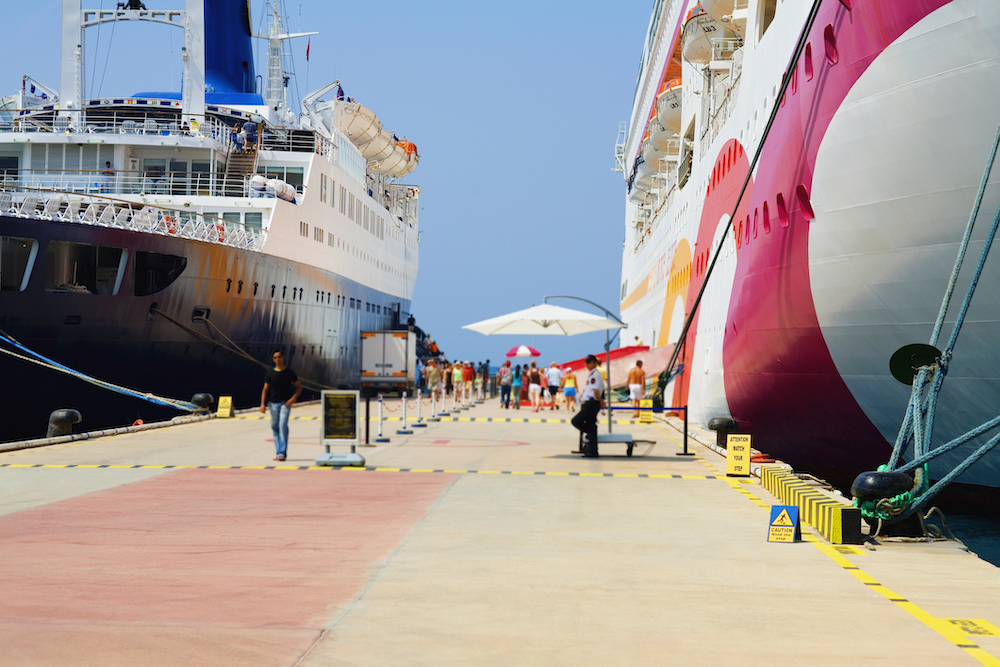- With cruise lines shut down, now might be the time for an environmental overhaul that shrinks the industry’s sizable carbon footprint.
- Still, some see little hope for change — with companies fighting for survival, new health and safety protocols will be among the only updates.
- Even before the pandemic, some cruise lines were instituting greener protocols and practices, such as debuting smaller boats, hiring local workers and eliminating single-use containers.
With so many cruise ships in dry dock, will the cruise lines use the pandemic pause to emerge with greener and more sustainable practices and products?
“This is a good opportunity for the cruise lines to engage in environmental and social governance (ESG), both from an environmental standpoint — reducing waste, reducing water, reducing emissions, improving poor dumping as well as grey- and black-water bilge efficiency, improving labor practices and sourcing locally,” Rachel Dodds, professor of hospitality and tourism management at Ryerson University and owner/director of the consulting firm Sustaining Tourism, told Karma in an email.
The Centers for Disease Control and Prevention (CDC) recently extended its No Sail Order for the third time, until September 30, to suspend nearly all cruise ship operations in waters subject to U.S. jurisdiction. Ships that carry fewer than 250 passengers are permitted to sail. Internationally, some cruises are also taking place.
When COVID-19 struck earlier this year, ships with sick passengers were stranded at sea while officials dealt with the fallout. Even before the pandemic, cruise ships have proven to be a Petri dish of illnesses.
In addition, its environmental record has been dismal because the industry uses millions of tons of heavy fuel, which emit substantial greenhouse gas emissions, and generates nearly a billion tons of sewage, which can potentially fog the air and pollute the water, possibly causing a litany of ugly environmental and health effects, according to The Guardian. And its presence at some ports of call has caused a degradation of local life.
Some companies, though, were making inroads in sustainability even before the pandemic. The most recent Friends of the Earth report card, which assesses sewage disposal, water-quality compliance and transparency among cruise lines, gave Disney Cruise Line an A-, the top grade, Norwegian a C, D’s for Royal Caribbean International, Celebrity Cruises, Silverseas Cruises, Regent Seven Seas and Oceana, and an F for MSC Cruises.
More recently, Royal Caribbean and Norwegian have joined forces to create a panel of experts, who will recommend best practices in health and safety in a report due later this month.
Some have introduced new products — such as Celebrity Cruises’ Flora, a division of Royal Caribbean — for Galapagos Islands tours that clearly aim for cleaner, greener sailing. Launched last year, the ship has 50 staterooms rather than the thousands that some cruise ships offer, and features environmental innovations, such as an anchorless component on the ship to avoid damaging the ocean floor. It also has some policies that other cruise lines have adopted — no single-use serving containers, increased recycling, and hiring local workers for the ship.
Size is an important point, Jonathon Day, associate professor at Purdue University’s School of Hospitality and Tourism Management, told Karma in an email. “Rather than using the biggest boat, Celebrity is using a smaller ‘mega-yacht’ that is better designed for the environment of the Galapagos,” added Day. “If cruise ships took this thinking and applied it to some of the more popular ports, such as Barcelona and Venice, it would significantly improve [cruising].”
According to Day, sustainability may take a backseat again, due to the industry’s financial state.
“While this pandemic pause is providing opportunity to plan for a better future, it is tempered by the fact that the industry is fighting for its survival — with many cruise lines unable to restart,” Day said. “It is difficult to bounce back better — improving sustainability at the same time as returning to profitability.”






















